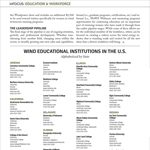You may have seen headlines recently involving institutions that provide career training and may be wondering what this means for the future of colleges specializing in wind-energy training such as Ecotech Institute of Denver.
The U.S. Department of Labor recently named wind technician as the fastest growing job in the country — expected to increase by 108 percent over the next 10 years. This trend is not limited to the U.S.
The whole world has turned its focus to renewable energy. With this increased demand, it’s more important than ever to properly prepare students interested in entering this rapidly growing industry.
The outlook for wind energy is bright, and the same can be said for the training that incorporates the following factors: relevance, quality, and value.
Relevance
In general, career training seems to be inversely related to the health of our economy. During the recession, colleges that offered training for industries that are recession-proof experienced healthy growth in enrollment and thus expansion of their programs.
There are few industries that remain strong through a recession. Those that offer widespread and enduring cost savings to industries and communities, such as automation, energy efficiency, and wind energy hold steadfast during economic downturns.
Programs that remain just as relevant following a recession, wind energy in particular, will tend to experience slightly slower but steady growth when national unemployment figures drop.
A simple search for jobs during the recession revealed the rapid expansion of the wind-energy industry offered solid job security and explosive demand for wind-turbine technicians.
The American Wind Energy Association (AWEA) recently released the 2015 U.S. Wind Industry Annual Market Report. According to the report, wind was the No. 1 source of new electric capacity in the U.S. As a result, the wind-energy industry supported an all-time high of 88,000 jobs in 2015.
Quality
Wind-turbine technicians must know how to maintain, diagnose, and repair nearly everything inside of a wind turbine.
Therefore, their education must include high-level training in electrical systems, mechanical systems, hydraulic systems, and control systems such as programmable logic controllers and SCADA. And, above all else, wind-turbine technician trainees must learn to work safely for the benefit of themselves and their coworkers.
The comprehensive skill set wind-energy technology students gain cannot be found in any other industry, and so employers compete with each other for the handful of wind-turbine technician program graduates available. The biggest complaint we hear from employers is, there are not enough trained applicants. Because of this, every graduating class at Ecotech Institute has stories of students receiving multiple job offers before graduation day.
Value
The value of any college or university should be measured based on the return on investment (ROI) to the graduate. President Barack Obama’s administration has initiated efforts to impose a “gainful employment rule” to ensure that programs are offering this value. This rule requires career colleges to prepare students for careers that will provide enough income that graduates will not pay more than 8 percent of their total earnings in a month toward their student loans.
For wind-turbine technician programs, the gainful employment rule poses no threat to the school’s good standing with the Department of Education. As an instructor, I receive anecdotal feedback regarding income directly from our wind-energy graduates. On the low end of the spectrum, students who choose not to travel for their first job in wind tend to make $50,000 to $75,000 per year. On the higher end of the range, I get reports of graduates making incomes in excess of $120,000 in their first year, though this is not common and requires considerable personal sacrifice in terms of constant travel and overtime.
Wind-turbine technician career college programs could, theoretically, survive for the next decade even if America stopped expanding our wind-energy portfolio all at once. Every turbine installed will need to be maintained and repaired for its 20-year service life, but within four to seven years of being new to the industry, wind-turbine technicians tend to get absorbed into the industry in other professional occupations that do not involve climbing turbines.
This means that there will be open positions in our industry regardless of the direction our national energy portfolio takes. Fortunately for our industry, the cost of producing profitable electricity from wind continues to decline, thus ensuring continued explosive growth worldwide. Therefore, we can count on healthy growth and longevity from high quality career college wind programs for decades to come.




































